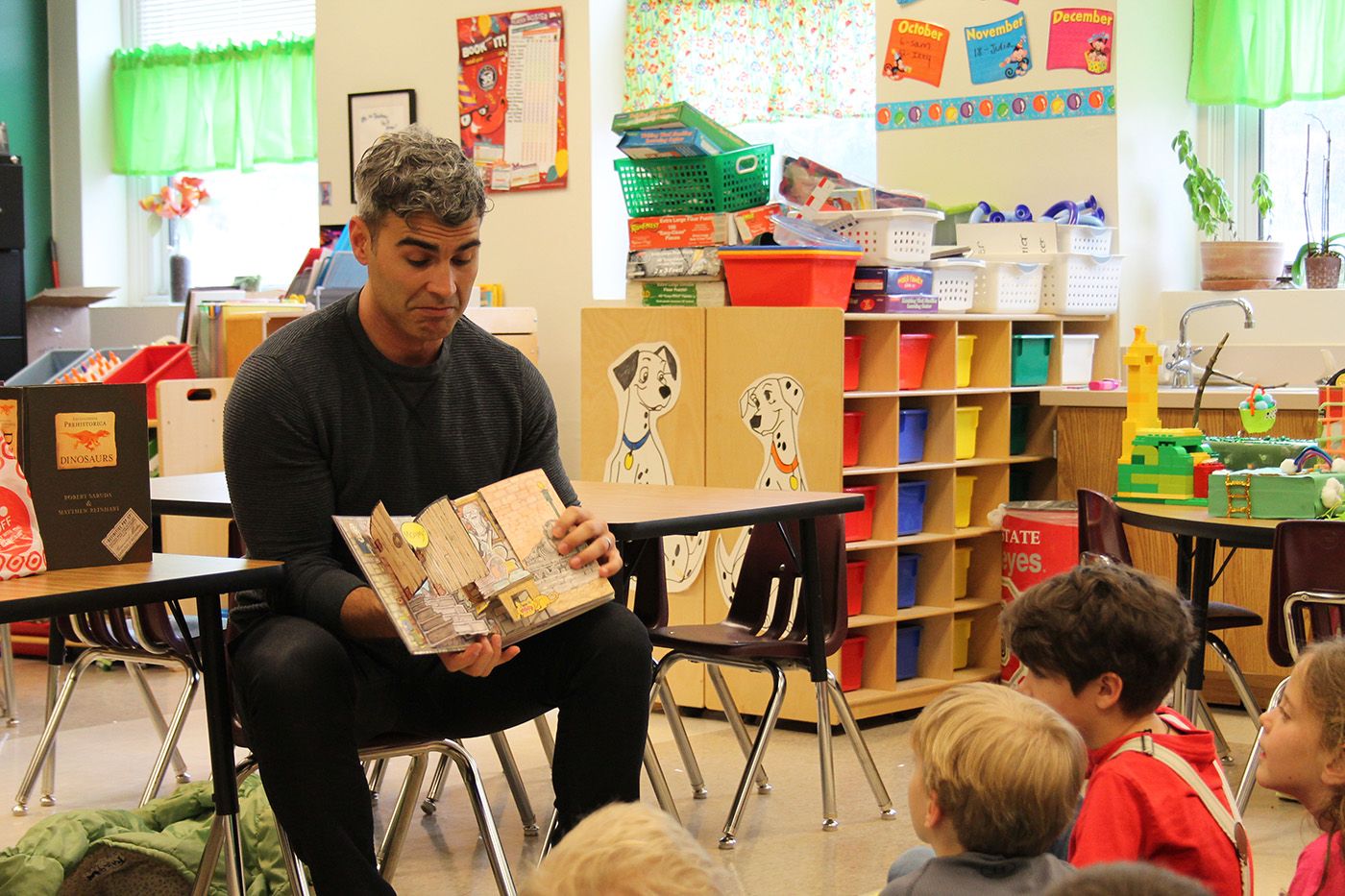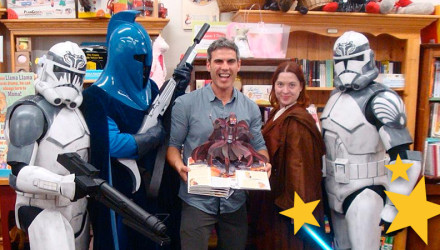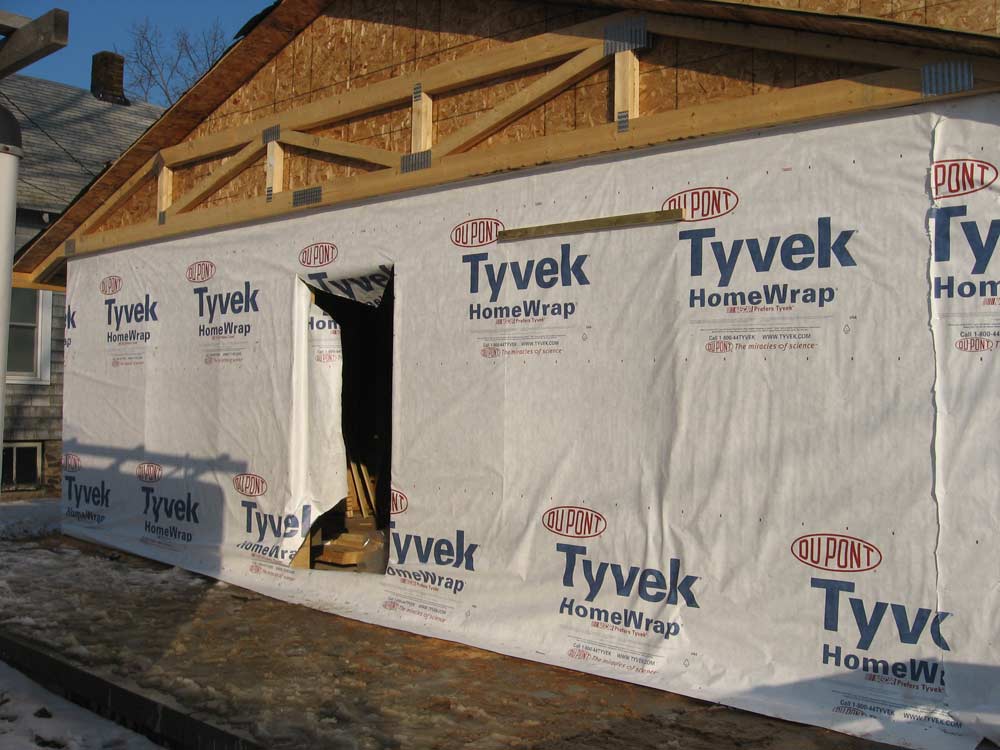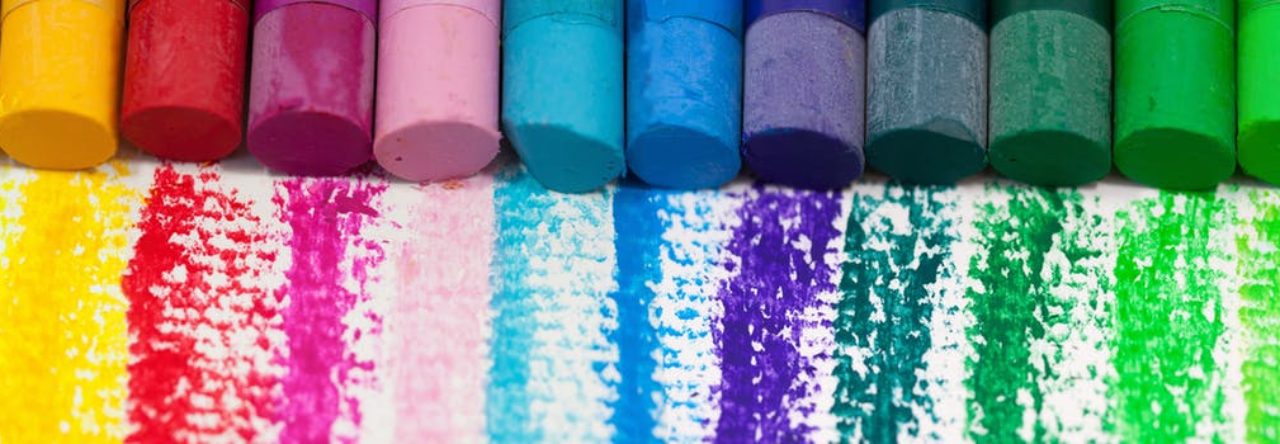 This month’s interview is with author/illustrator Matthew Reinhart, an artist whose life feels parallel to mine in all kinds of nifty ways. For example:
This month’s interview is with author/illustrator Matthew Reinhart, an artist whose life feels parallel to mine in all kinds of nifty ways. For example:
Matt’s folks are from Iowa (Cedar Rapids).
My folks are from Iowa (Des Moines)!
Matt’s dad was the son of a farmer.
My mom was the daughter of a farmer!
Matt’s dad served in the Navy.
My dad served in the Air Force!
Matt has a sister named Erin.
I have a brother named Aron!
Matt’s an avid fantasy and science fiction fan.
I’m an avid fantasy and science fiction fan!
Matt was a student at Clemson University.
I was a professor at Clemson University (alas, not one of Matt’s)!
Matt has lived “all over,” including South Carolina, Illinois, and Florida.
I’ve lived “all over,” including South Carolina, Illinois, and Florida!
Matt’s bio says he’s “married and busy with work.”
My bio says I’m “married and busy with work”!
Are you starting to see why I’m so intrigued by Matt, my artistic and—let’s be honest here—all-around-general-life doppelgänger?
Let me just add one more parallel, which is perhaps the most awesome pairing of all.
- Matt makes awesome pop-up books.
- I love to read awesome pop-up books!
 Do you see why we’re practically best friends, despite only meeting (virtually, at that!) a few weeks back?
Do you see why we’re practically best friends, despite only meeting (virtually, at that!) a few weeks back?
Let’s jump right ahead to the interview and see what YOU might have in common with my good pal, Matt. (My guess is “A lot!”)
website: www.matthrewreinhart.com
YouTube: https://www.youtube.com/channel/UCxbY5VDdSrdvcMBvZBqvChA
Twitter: https://twitter.com/MatthewReinhar1
Facebook: https://www.facebook.com/Pop-Up-Books-by-Matthew-Reinhart-263860686940/
Instagram: https://www.instagram.com/matthewcreinhart/
RVC: Your website’s ABOUT section says that “from before Matthew could remember, art always took center stage.” At what point did you pick up writing, and how did that addition to your creative arsenal change things for you?
MR: Words were not my medium when I was young–pictures were my primary language. Back when I began making children’s books, I needed to learn quickly how to write despite the fact that there’s often very little room left on the page after the pop-ups go in! I guess research and writing was something I was always pretty good at and, over the years, I think I’ve gotten better thanks to the help of talented editors.
I’d love to go back to school for creative writing–I’ll put that on my “to do” list!
RVC: If you ever do decide to go back to college to study creative writing, keep our program at Ringling College in mind. We especially cater to visually-oriented writers in a host of ways.
**Okay, the horn-tooting PR moment is now over.**
Back to the interview–like me in my teen years, you were concerned that an artistic future maybe wasn’t the best option. I wanted to play guitar (at first) and (later) become a writer. You wanted to be an artist, but you attended Clemson to study biology in preparation for attending med school. What type of doctor did you think you’d be? And how did studying the human body help with your art?
MR: Honestly, I’m not sure how much I actually thought about much back then, let alone what type of doctor I wanted to be. I just sort of did what was expected of me. I think there was a time when I wanted to be a plastic surgeon, mainly because I thought I could have a profitable medical career. Pretty altruistic goals, huh? It was ridiculous idea, actually, because all of my sketchbooks were filled with monsters, mutants, space aliens, and robots. I mean, if I had been a plastic surgeon I might’ve grafted on extra eyes, antennae, and cyborg implants!
I will say that studying anatomy, biology, botany, and zoology helped immensely with art. It’s important when either drawing, painting or paper engineering a living thing that I understand its structure, how it moves and its placement in nature.
RVC: What changed in terms of your plans? What gave you courage to go from Clemson to New York City and NOT start medical school right away?
MR: What changed was that I actually got into medical school right after Clemson and I didn’t want to go! So, I told my parents I needed a year away from any schooling, moved to New York City for a year, and worked at an organ procurement organization taking corneal tissue from donor cadavers. Yes, you heard that right–I took out dead peoples’ eyeballs! Gruesome, eh?
That job gave me a lot of perspective about life and a future career. Life is short, and work takes up a LOT of time. I wanted a career that really made me happy, to be fulfilled. So, I made the plunge and never looked back.
RVC: Let’s talk about the Pratt Institute. After a year of eyeball procurement (now that’s a phrase I never thought I’d write!), you applied there and got accepted into the industrial design track with an eye (no pun intended!) toward making toys. What are some of the most valuable lessons you took away from those classes?
MR: My time at Pratt was just two years long–a quick graduate degree in industrial design was all I could afford. I had the talent and ability, but my Pratt classes really honed them into something viable for a career. My color theory professor, in particular, made a big impression on me–I learned to use color more intelligently, to manipulate palettes that could help tell stories.
My work after Pratt, however, was my real education–just getting thrown into pop-up design headfirst. That, in my opinion, is the very best way to learn and grow creatively.
RVC: Say a few words about your friend and mentor, children’s book author Robert Sabuda. What type of influence did he have on your career?
MR: I wouldn’t have the career I have without him. I’m very thankful for our time together and the classic books we created together.
RVC: I can’t go any further without asking you directly about pop-up books, because, well, I LOVE pop-up books. When did you first learn that you had the knack for making these clever, tricky, amazing, wonderful things?
MR: I think I had it many years before I even started working as a pop-up book apprentice but I didn’t even realize it. In high school and college, I made elaborate mix-tapes (long before smartphones carried all our favorite tunes) for my friends which often included illustrated comics. A few of them even had very simple pops, but I only have one to show for it today.
Aside from that, I was always making things out of paper and cardboard–that was all we had around the house that I could build with as a kid. You make do with what you’re given–I was always scavenging up any box, Styrofoam, cardboard, anything to make what was in my head!
 RVC: What’s the story of your first published pop-up book, The Pop-Up Book of Phobias? How did it come about, and what surprises did you encounter along the way?
RVC: What’s the story of your first published pop-up book, The Pop-Up Book of Phobias? How did it come about, and what surprises did you encounter along the way?
MR: Robert Sabuda was offered the book, but he couldn’t do it, so I got offered the job by the publisher Melcher Media. I thought the book was an odd concept initially, to be honest, and didn’t even think it would end up being produced. We were rushed, too, so I don’t really remember much, other than having to build that damn toilet pop-up 20 times over!
My biggest surprise was that the book was a moderate hit. I’ve since developed a fondness for the book and am proud to have been a part of making it memorable.
RVC: You’ve gone on to create pop-up books for some of the biggest pop culture franchises, such as Star Wars, Game of Thrones, Frozen, Transformers, My Little Pony, DC superheroes, LEGO, and more. Which one were you most stoked to work with/for purely on a personal fanboy level?
MR: Star Wars is my number one, with Transformers a very, very close second. Both franchises very much inspire me to this day.
RVC: Those are two of my favs, as well. Speaking of things that inspire us, tell us–what was it like working with picture-book legend Maurice Sendak?
MR: It was an incredible experience for me. Here I was, this young inexperienced artist collaborating with this legend, Maurice Sendak! I was sort of blown away at his openness to listen to my opinion and vent his own insecurity with his work. Many artists are insecure about their work, no matter the level of success.
Maurice had an irreverent sense of humor and he always tried to shock me with what he could say. I’d seen and done pretty much everything, though, so I was rarely fazed. I miss him and will always be thankful for our friendship.
RVC: And what about working with Tomie DePaola?
MR: Tomie was wonderful to work with and really a fast learner. Once we gave him the specifics, he ran with it and made his artwork at lightning pace. He’s continued to be a friend and inspiration.
RVC: In one of your YouTube Pop-Up Master Class videos, you mention how some of your best work emerges from playing around with paper. When you’re deep in the throes of paper experimenting, how much paper might you go through in a single workday?
MR: Eek! I don’t want to think about that!
Most of the time, the paper I use and toss is in messy pieces so it’s unusable when I need to toss it. I try NOT to throw paper away if I can do anything about it, but if I had to guess? Hmmm … 3–4 letter-sized sheets during those times of unbridled paper experimentation.
RVC: What’s the most common misconception about pop-up books?
MR: The common misconception is that pop-up books are silly little books for kids. No book is ever silly, unless of course, they’re meant to be! Often folks tell me they’re shocked by how complicated, impressive, and sophisticated some of the titles I’ve worked on are. They want to keep the books all for themselves and not share them with their kids, which I think is hilarious. I just try to make a book that’s interesting for everyone, including myself.
RVC: What have you not yet done in a pop-up book that you’d like to try?
MR: Scented elements! I’ve always wanted to make a food pop with scratch-n-sniff pop-ups.
You heard it first–Stinky Pops by Matthew Reinhart, coming sometime soon!
RVC: In all your experience with the world of picture books (of which pop-up books are a part), what has surprised you the most?
MR: I’m surprised that despite all the advances of entertainment technology, digital media, and online story content, kids still like to curl up with a book. Reading a book is a personal one-on-one thing. There’s something about turning each page, holding the book, and taking it wherever.
School book fairs are as popular and important as ever. Books still matter–and I’m happy for that, as are all book-makers, without a doubt.
RVC: It’s time now for the much-ballyhooed, always-interesting, and rarely-equaled SPEED ROUND! High-octane questions and potent-pithy answers, please. Are you ready?
MR: Yup!
RVC: Favorite type of cheesecake?
MR: Dulce De Leche Cheesecake or Oreo Cheesecake–pretty much any sort of candy or sweet (aside from fruit, which should never invade dessert, in my opinion) you can add to cheesecake is fine by me.
 RVC: Craziest “paper” you’ve ever worked with?
RVC: Craziest “paper” you’ve ever worked with?
MR: Tyvek–that untearable, waterproof “paper” used to make FedEx envelopes/packs and homewrap.
RVC: Crayola color that doesn’t yet exist, but you wish it did!
MR: Phosphorescent lime green.
RVC: Most unexpected source of inspiration for your paper art?
MR: Anything, to me, can be inspiration–so I wouldn’t characterize something that inspires me like that at all.
RVC: Favorite pop-up book created by someone not named Matthew Reinhart?
MR: Hmmm… that’s tough. There are a lot! I’d say number one is Haunted House by Jan Pienkowski.
RVC: Three words that describe what being an artist means to you?
MR: MAKE FANTASIES REAL.
RVC: Thanks so very much, Matthew!




